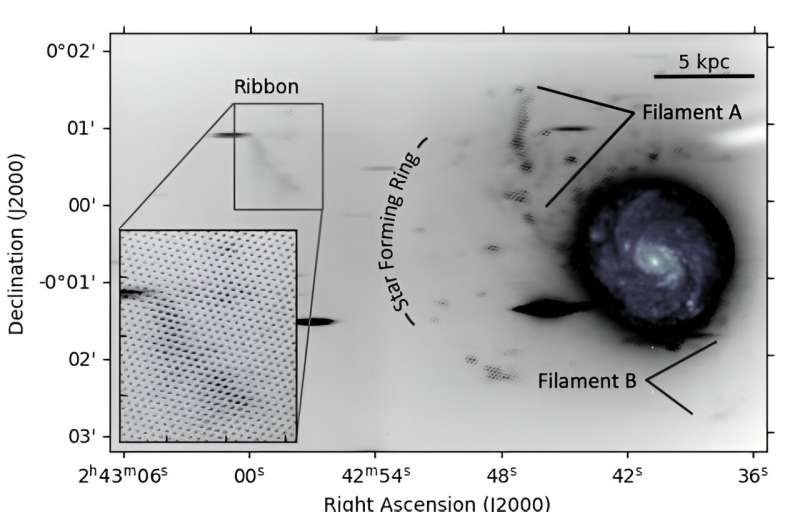August 29, 2024 report
This article has been reviewed according to Science X's editorial process and policies. Editors have highlighted the following attributes while ensuring the content's credibility:
fact-checked
peer-reviewed publication
trusted source
proofread
Astronomers detect extended ionized gas around Messier 77

Using the Circumgalactic H-alpha Spectrograph (CHαS), astronomers have performed spectroscopic observations of a nearby active galaxy designated Messier 77. They detected a very extended structure of ionized gas around this galaxy. The finding was reported in a research paper published August 22 on the preprint server arXiv and accepted for publication in The Astrophysical Journal.
Messier 77 (or M77 for short, also known as NGC 1068) is a barred spiral galaxy located some 47 million light years away. It hosts an active galactic nucleus (AGN), which globally ionizes gas in its disk and halo. Messier 77 is the closest type 2 Seyfert galaxy and is considered to be a prototype of this class. The galaxy is estimated to be 90,000 light years in diameter and its mass is about 1 billion solar masses.
Recently, a team of astronomers led by Nicole Melso of the Steward Observatory in Tucson, Arizona, has employed CHαS on the Hilter 2.4-m telescope at MDM Observatory in Arizona, to conduct wide-field spectral imaging of Messier 77. The main aim of their observations was to inspect ionized gas distribution around this galaxy.
"We have performed wide-field, ultra-low surface brightness hydrogen-alpha emission line mapping around NGC 1068 with the newly commissioned Circumgalactic Hα Spectrograph (CHαS)," the researchers wrote.
Melso's team identified an extended emission around Messier 77, located beyond previously detected filament structures in this galaxy, towards the edge of the CHαS field of view. This emission turned out to be in the galactic halo at an angular distance of approximately 292 arcseconds from the galactic center.
The astronomers labeled the newfound extended structure of ionized gas "the Ribbon." Based on the CHαS observations, it was found that the Ribbon has a projected physical radius of about 66,500 light years.
The collected data indicate that the Ribbon gas is not associated with any galactic structure or known tidal features in the halo of Messier 77. Moreover, unlike what is observed in filaments closer to the galaxy, the Ribbon gas is slightly misaligned with the current axis of the central jet.
The results also suggest that the Ribbon gas is most likely composed of young stars embedded in warm line-emitting gas ionized by a mix of processes. However, further investigation of this gas should be conducted in order to shed more light on its origin and composition.
"Follow-up observations of the neutral atomic and molecular gas in the filament and Ribbon structures will be important for understanding the origin of the Ribbon gas located in the circumgalactic medium of NGC 1068, the amount of gas available for star-formation, and the level of AGN-induced star formation occurring in these regions," the authors of the paper concluded.
More information: Nicole Melso et al, Very Extended Ionized Gas Discovered around NGC 1068 with the Circumgalactic Hα Spectrograph, arXiv (2024). DOI: 10.48550/arxiv.2408.12597
Journal information: Astrophysical Journal , arXiv
© 2024 Science X Network





















